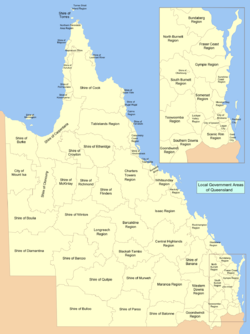
Red=Aboriginal Shires
Green=Cities
Yellow=Regions
Orange=Shires
Purple=Town

Local government in Queensland, Australia, includes the institutions and processes by which towns and districts can manage their own affairs to the extent permitted by the Local Government Act 1993–2007. Queensland is divided into 78 local government areas, which may be called Cities, Towns, Shires, or Regions.[1] Each area has a council that is responsible for providing a range of public services and utilities and derives its income from both rates and charges on resident ratepayers and grants and subsidies from the state and Commonwealth governments.[2]
As bodies which obtain their legitimacy from an Act of the Queensland Parliament, local councils are subordinate rather than sovereign entities[3] and can be created, amalgamated, abolished, or dismissed by the state at will. In modern practice, however, decisions on such matters are made in response to recommendations by independent Reform Commissions, such as the Electoral and Administrative Reform Commission (1990–1993) and the Local Government Reform Commission (2007). Recent reforms, which took effect on 15 March 2008, resulted in over 70% of Queensland's local government areas being amalgamated into larger entities and generated a considerable degree of controversy, even attracting national interest in the context of a federal election campaign.[4]
As a result of Queensland and New South Wales local government amalgamations, Australia's three largest-by-population local government areas are all in Queensland:
| Rank | Local government area | Population (2018)[5] |
Population (2021) |
|---|---|---|---|
| 1 | City of Brisbane | 1,231,605[5] | 1,242,825[6] |
| 2 | City of Gold Coast | 606,774[5] | 625,087[7] |
| 3 | City of Moreton Bay | 459,585[5] | 476,340[8] |
- ^ Local Government Act 1993 Archived 10 April 2008 at the Wayback Machine, s.34. (Reprint 11E, as in force at 22 November 2007.)
- ^ Department of Local Government, Sport and Recreation (Queensland) (26 July 2007). "Rates and valuations". Archived from the original on 19 March 2008. Retrieved 5 April 2008.
- ^ Harris, C.P. (1985). Occasional Paper No. 35: Local Government in Queensland. Canberra: Australian National University. p. 2. ISBN 0-86784-567-8.
- ^ Van Vonderen, Jessica (10 August 2007). "Week in parliament". Stateline (ABC). Archived from the original on 11 May 2011. Retrieved 5 April 2008.
- ^ a b c d "3218.0 – Regional Population Growth, Australia, 2017-18: Population Estimates by Local Government Area (ASGS 2018), 2017 to 2018". Australian Bureau of Statistics. Australian Bureau of Statistics. 27 March 2019. Archived from the original on 27 March 2019. Retrieved 25 October 2019. Estimated resident population, 30 June 2018.
- ^ Australian Bureau of Statistics (27 June 2017). "Brisbane (LGA)". 2016 Census QuickStats. Retrieved 7 December 2024.
- ^ Australian Bureau of Statistics (28 June 2022). "Gold Coast (LGA)". 2021 Census QuickStats. Retrieved 7 December 2024.
- ^ Australian Bureau of Statistics (28 June 2022). "Moreton Bay (LGA)". 2021 Census QuickStats. Retrieved 7 December 2024.
